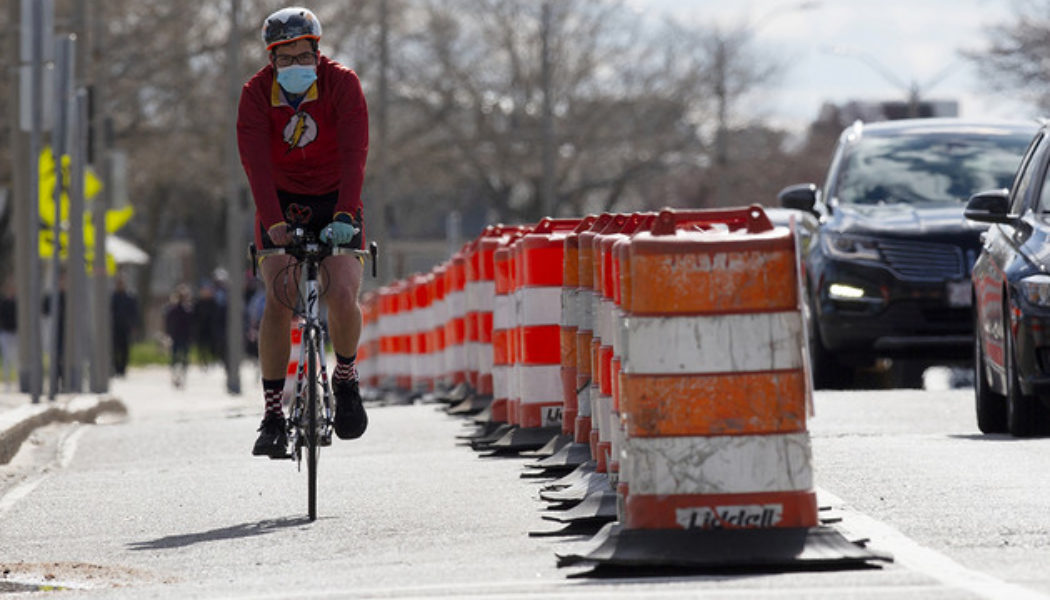“People are saying ‘Where are the projects?’” Robert Bullard, a Texas Southern University professor and member of Biden’s White House Environmental Justice Advisory Committee, said of frustration in communities of color. “They know the pressure they’re going to be under with the midterms. There has to be something tangible rolled out because these people stood for hours in line [to vote] during the pandemic and they’re going to be asked to do it again in November — and if nothing happens they’re going to ask, ‘Why?’”
Biden’s inability to control how a large portion of the infrastructure money gets spent is largely due to legal constraints. About 75 percent of the infrastructure law will be distributed to states via a complicated formula set by existing statute, including the bulk of federal highway dollars.
Communities that have for decades been on the short end of federal funding worry that these constraints will leave them in the same position, missing out on historic cash infusions.
“Environmental justice communities have faced more [hardship] than many people have faced in this society, in this country. We have paid with our lives, with our blood, with our labor in addition to the taxes and whatever else we bring to the table,” said Donele Wilkins, CEO of Detroit-based environmental justice group Green Door Initiative. “We just want to get a return on our investment wherever we can get it.”
Water infrastructure spending also highlights the dynamic. The law injects $50 billion into drinking water and wastewater infrastructure, lead pipe removal and cleaning up toxic contaminants, but most funding flows through state-run revolving loan funds. Yet just 10 percent — $5 billion — will go to “small and disadvantaged communities.” That’s despite the White House and Democrats calling attention to low-income residents struggling to afford their water bills and lead poisoning disproportionately plaguing communities of color.
Federal agencies have largely tried to nudge states to support the administration’s goals and address these funding inequities. EPA issued a 56-page memo earlier this month outlining recommendations and requirements to ensure the revolving funds hit equity targets, such as setting aside a portion of those funds for technical assistance to identify communities in need, help them develop projects and assist with applications. The Federal Highway Administration, similarly, is “encouraging” states to invest their formula dollars on repair and improvements before building new highways, but its statutory and regulatory tools to ensure compliance are limited.
While the bill puts tremendous power in the hands of state transportation departments, which historically have preferred to use their money to build highways instead of transit and walking and biking infrastructure, Transportation Department Deputy Secretary Polly Trottenberg said these days, a lot of state DOTs don’t need to have their arms twisted into looking at carbon emissions and social equity.
“Just as U.S. DOT is evolving, a lot of state and local DOTs are evolving as well,” she told POLITICO in an interview.
But prying federal dollars loose from state governors and legislatures isn’t always easy. Some environmental justice advocates and community leaders have worried aloud that Republican-run states opposed to Biden’s political objectives would stifle funds from flowing to Democratic strongholds.
“We have to do a really better job of making sure there’s a fair allocation of these resources from the statehouse to the communities that are more desperately in need — not places that voted for you for governor,” said Greenville, Miss. Mayor Errick Simmons, who is a Democrat. “The funds are coming from the federal government to help folks particularly that are more in need. They may not look like you, but they are Mississippians, and they need help.”
Mississippi, which has a Republican governor and statehouse, has only just begun spending the $1.8 billion it received through the $1.9 trillion coronavirus pandemic relief funds Congress passed in March 2021.
With states controlling so much of the investment in play, activists are working across several states to ensure the federal dollars Biden promised to pollution-ravaged communities actually make it to those areas.
Legislation, regulations and executive orders are being utilized in a handful of states to try to create environmental justice spending oversight committees to give communities of color, rural towns and low-income neighborhoods more say at how states steer federal money as well as align with the Biden administration’s goals to eliminate environmental and economic burdens in these communities.
So far Delaware, which has a Democratic governor and legislature, is the only state to enact such an accountability panel. Similar efforts are afoot in North and South Carolina, while the idea is being discussed in other states including Kentucky, Michigan, Florida, Illinois, Louisiana and Nebraska.
“If you don’t put in the guardrails and the teeth, this money will get spent anywhere and everywhere,” said Harold Mitchell Jr., who is spearheading the efforts through his environmental justice group ReGenesis Institute and is a member of the White House Environmental Justice Advisory Council.
The effort comes as the administration has decided against including race as a determining factor in the president’s promise to steer 40 percent of the benefits from federal programs to disadvantaged communities. Some environmental justice advocates argued failing to consider race avoids confronting the chief reason certain neighborhoods face higher economic, employment, health and environmental burdens.
“Folks may be missed,” said Mustafa Santiago Ali, a former EPA career staffer who now leads environmental justice efforts at the National Wildlife Federation. “There are middle-income Black communities and communities of color that are being impacted.”
Early analysis shows that is already happening.
Advocacy group Climate Nexus in March found the Biden administration’s environmental justice screening tool overlooked 2,854 Census tracts with a majority-minority population that surpassed one of eight climate and environmental indicators. The tool is how the Biden administration is identifying which communities are eligible for the 40 percent of benefits intended for “disadvantaged” areas.
The Biden administration would use that tool to determine spending over grant-driven initiatives, the portion of the law not bound by statutory formulas that automatically dispense cash to states. It has already started opening up programs with eye-popping dollar figures: $52.5 billion for highways, $27 billion for bridge repair and replacement, $7.4 billion for water systems, $3.5 billion for rural and tribal broadband and more so far.
Minority and rural communities, like the ones the Biden administration seeks to boost, may be at a disadvantage next to their richer, more populous neighbors when it comes to finding the time and expertise to put together winning applications. Such concerns are common among small communities that don’t have the resources to have in-house experts or hire consultants to write applications tailor-made to the administration’s goals and interests and in compliance with every iota of agency guidance.
In a November letter to governors, EPA Administrator Michael Regan said his agency will provide technical assistance to disadvantaged communities that want to apply for funds — but that process will take time.
Formula-driven funding can be attractive to administrations looking to champion their accomplishments because getting such funding out the door is easier, requiring less review time. Yet such formulas have systematically reinforced a divide between who does and doesn’t receive resources. Sen. Martin Heinrich (D-N.M.) said while states receive significant portions of wildlife management funding, the formulas fail to give Native American tribes a fair share of those dollars.
“There are lots of examples where … tribal communities are just not baked into the funding formulas. That’s not just true for climate,” Heinrich said. “I think we need to look at those formulas across the board and make sure we’re dispersing those federal resources equitably.”
The formula funding calculations or disbursements could have been adjusted by the infrastructure bill, but weren’t. On transportation funding, Republicans opposed Democrats’ desires to insert policies to steer money away from highway building in rural areas and toward public transit programs that would have benefited largely Democrat-voting cities. Instead, agencies are issuing memos, guidance or exploring top-down changes to formulas to advance the administration’s goals when possible.
Federal Emergency Management Agency Assistant Administrator for Resilience Victoria Salinas said scoring changes her agency made for several grant programs increased first-time applications. With climate resilience efforts snagging $47 billion from the infrastructure bill, her agency has the potential to steer buckets of money.
Salinas said FEMA is having preliminary discussions around further changes to those formulas, such as giving more points to projects “supporting underserved communities” by tweaking the agency’s emphasis on sending aid to areas with higher property values.
“It’s all these small things that lead to systemic inequity that there’s an openness to review and change, which I’m really excited for,” Salinas said.
Tanya Snyder and Annie Snider contributed to this report.
[flexi-common-toolbar] [flexi-form class=”flexi_form_style” title=”Submit to Flexi” name=”my_form” ajax=”true”][flexi-form-tag type=”post_title” class=”fl-input” title=”Title” value=”” required=”true”][flexi-form-tag type=”category” title=”Select category”][flexi-form-tag type=”tag” title=”Insert tag”][flexi-form-tag type=”article” class=”fl-textarea” title=”Description” ][flexi-form-tag type=”file” title=”Select file” required=”true”][flexi-form-tag type=”submit” name=”submit” value=”Submit Now”] [/flexi-form]









